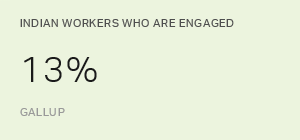WASHINGTON, D.C. -- Indians' economic optimism rose significantly in 2010 after tumbling amid the global recession. Between 2007 and 2009, the percentage of Indians who thought their local economic conditions were getting better dropped from 52% to 37%, but rebounded to 45% in 2010.
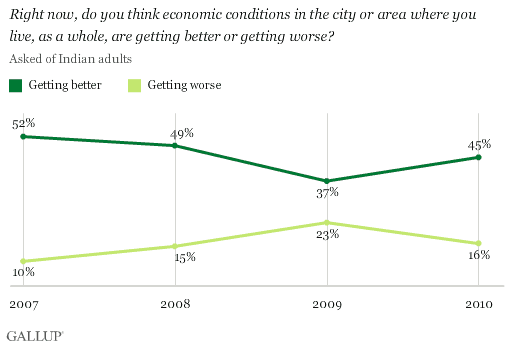
Indians' perceptions about their own standard of living follow a similar pattern. This year, 44% of Indians say their standard of living is improving, up from 32% last year. This year's figure is identical to the finding from July 2008, before the severity of the global downturn was fully apparent.
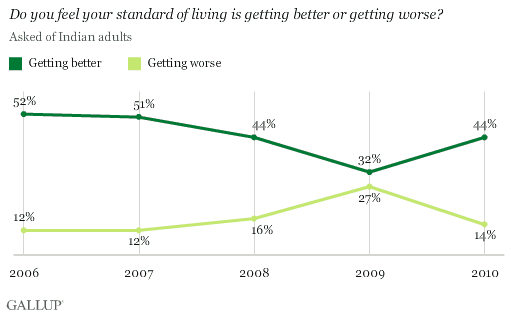
This rising optimism synchs with reported economic growth. After dipping below 6% in 2008/2009, India's real GDP growth exceeded 7% in 2009/2010 and is expected to approach 9% this year. However, the country's prosperity is spread unevenly. Large income disparities exist between urban and rural areas and across regions.
Regional results indicate the recession's effects were more severe for some Indians than others. The country's South and West regions are where industrial activity and the IT sector are concentrated, and they include major economic hubs of Bangalore and Mumbai. In these regions, 52% say their standard of living is improving vs. 39% in the less developed North, Central, and East regions. Though optimism has rebounded in urban and rural areas, the recession in 2009 affected India's poorer regions more dramatically.
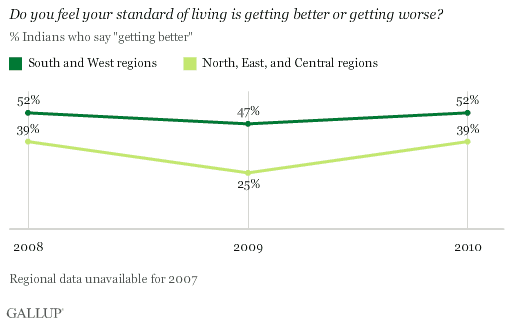
Views About the Job Market Yet to Rebound
Most of Gallup's indicators of economic optimism in India turned upward in 2010, with one significant exception: The proportion of Indians who say it is a good time to find a job in their city or area remained flat at about one-third. Employment rates tend to lag behind other indicators of economic improvement, as economists have noted in reference to high ongoing jobless rates in the United States and other countries, because employers hesitate to resume hiring until they are convinced of a robust recovery.
India may be particularly susceptible to a "jobless recovery" because its labor force is growing rapidly and because most of India's growth is based on skill-intensive activities, rather than labor-intensive activities that would employ more people. That means large swaths of Indians are unable to participate in fueling the country's economic growth. Significant regional differences in perceived job opportunities reflect this. A majority of Indians living in the southern and western states (54%) say now is a good time to find a job; this figure has hardly moved over the last two years. By contrast, 16% of Indians in the northern, eastern, and central states say it is a good time to find a job, down from 35% in 2008.
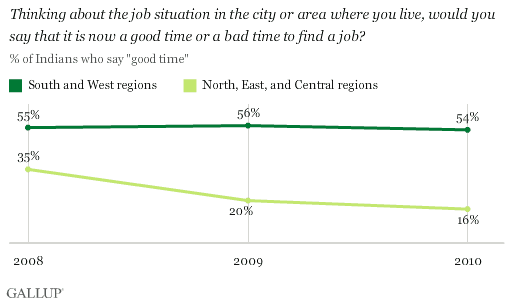
Implications
Any rebound in Indians' economic optimism should be welcome news not just to the Indian government, but also to a global community eyeing the country's emerging markets. In an editorial published in India during President Barack Obama's visit there last week, U.S. Treasury Secretary Timothy Geithner praised India's "balanced growth," citing its reliance on domestic demand and exports.
However, Gallup's data also make it clear that not all Indian consumers are likely to increase demand. Stark inequalities remain between regions that have enjoyed rapid economic development and those that have not. These inequalities have also triggered social instability, including the rise of a Maoist insurgency in eastern and central India and secessionist groups in the Northeast. The Indian government has promised to make the country's growth more inclusive by investing heavily in rural education, health, and infrastructure. Future surveys will help gauge how successful these efforts are in closing India's "optimism gap."
For complete data sets or custom research from the more than 150 countries 优蜜传媒continually surveys, please contact SocialandEconomicAnalysis@gallup.com or call 202.715.3030.
Survey Methods
Results are based on face-to-face interviews with 6,000 Indian adults, aged 15 and older, conducted in June 2010. For results based on the total sample of national adults, one can say with 95% confidence that the maximum margin of sampling error in 2010 is 卤1.7 percentage points. The sample sizes and margins of error for previous surveys were as follows: February 2006: 2,100 adults, 卤3.6 percentage points; May 2007: 3,186 adults, 卤2.1 percentage points; July 2008: 2,000 adults; 卤3.4 percentage points; November 2009: 3,010 adults, 卤2.6 percentage points. The margin of error reflects the influence of data weighting. In addition to sampling error, question wording and practical difficulties in conducting surveys can introduce error or bias into the findings of public opinion polls.
Regional results group India's 20 states as follows: 1) Central: Chhattisgarh, Madhya Pradesh; 2) East: Bihar, Jharkhand, Orissa, West Bengal; 3) West: Gujarat, Maharashtra; 4) North: Delhi, Haryana, Himachal Pradesh, Jammu and Kashmir, Punjab, Rajasthan, Uttar Pradesh, Uttarakhand; and 5) South: Andra Pradesh, Karnataka, Kerala, Tamil Nadu.
